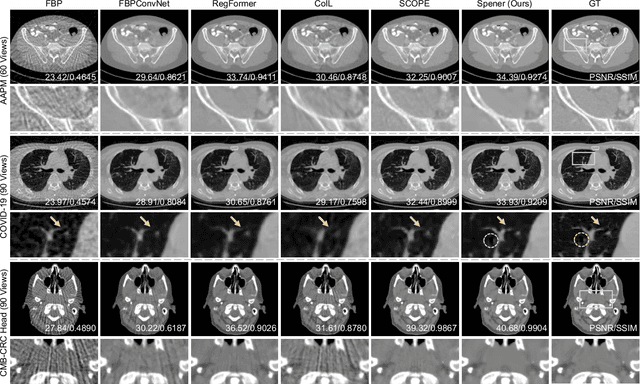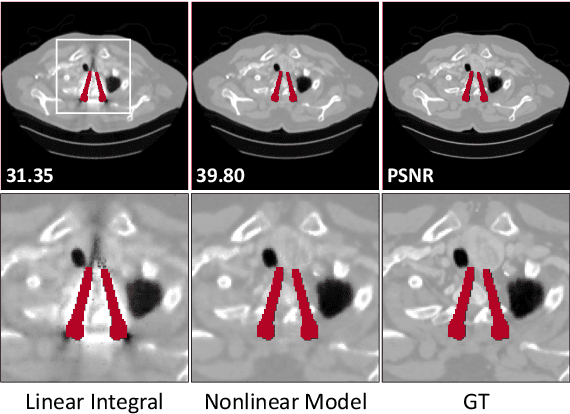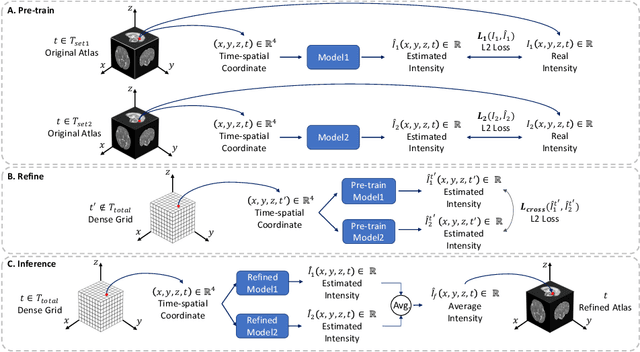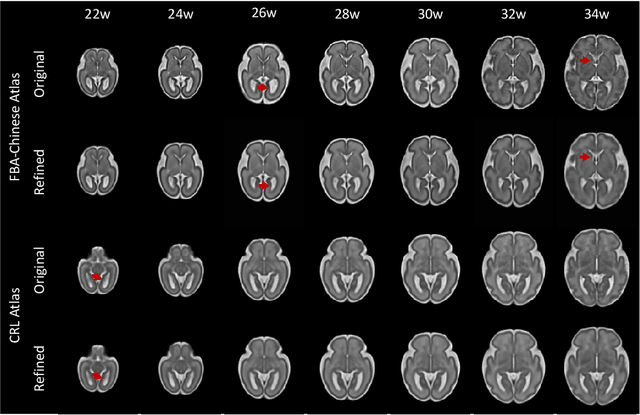Lixuan Chen
SUFFICIENT: A scan-specific unsupervised deep learning framework for high-resolution 3D isotropic fetal brain MRI reconstruction
May 26, 2025Abstract:High-quality 3D fetal brain MRI reconstruction from motion-corrupted 2D slices is crucial for clinical diagnosis. Reliable slice-to-volume registration (SVR)-based motion correction and super-resolution reconstruction (SRR) methods are essential. Deep learning (DL) has demonstrated potential in enhancing SVR and SRR when compared to conventional methods. However, it requires large-scale external training datasets, which are difficult to obtain for clinical fetal MRI. To address this issue, we propose an unsupervised iterative SVR-SRR framework for isotropic HR volume reconstruction. Specifically, SVR is formulated as a function mapping a 2D slice and a 3D target volume to a rigid transformation matrix, which aligns the slice to the underlying location in the target volume. The function is parameterized by a convolutional neural network, which is trained by minimizing the difference between the volume slicing at the predicted position and the input slice. In SRR, a decoding network embedded within a deep image prior framework is incorporated with a comprehensive image degradation model to produce the high-resolution (HR) volume. The deep image prior framework offers a local consistency prior to guide the reconstruction of HR volumes. By performing a forward degradation model, the HR volume is optimized by minimizing loss between predicted slices and the observed slices. Comprehensive experiments conducted on large-magnitude motion-corrupted simulation data and clinical data demonstrate the superior performance of the proposed framework over state-of-the-art fetal brain reconstruction frameworks.
Unsupervised Self-Prior Embedding Neural Representation for Iterative Sparse-View CT Reconstruction
Feb 08, 2025



Abstract:Emerging unsupervised implicit neural representation (INR) methods, such as NeRP, NeAT, and SCOPE, have shown great potential to address sparse-view computed tomography (SVCT) inverse problems. Although these INR-based methods perform well in relatively dense SVCT reconstructions, they struggle to achieve comparable performance to supervised methods in sparser SVCT scenarios. They are prone to being affected by noise, limiting their applicability in real clinical settings. Additionally, current methods have not fully explored the use of image domain priors for solving SVCsT inverse problems. In this work, we demonstrate that imperfect reconstruction results can provide effective image domain priors for INRs to enhance performance. To leverage this, we introduce Self-prior embedding neural representation (Spener), a novel unsupervised method for SVCT reconstruction that integrates iterative reconstruction algorithms. During each iteration, Spener extracts local image prior features from the previous iteration and embeds them to constrain the solution space. Experimental results on multiple CT datasets show that our unsupervised Spener method achieves performance comparable to supervised state-of-the-art (SOTA) methods on in-domain data while outperforming them on out-of-domain datasets. Moreover, Spener significantly improves the performance of INR-based methods in handling SVCT with noisy sinograms. Our code is available at https://github.com/MeijiTian/Spener.
Unsupervised Density Neural Representation for CT Metal Artifact Reduction
May 11, 2024



Abstract:Emerging unsupervised reconstruction techniques based on implicit neural representation (INR), such as NeRP, CoIL, and SCOPE, have shown unique capabilities in CT linear inverse imaging. In this work, we propose a novel unsupervised density neural representation (Diner) to tackle the challenging problem of CT metal artifacts when scanned objects contain metals. The drastic variation of linear attenuation coefficients (LACs) of metals over X-ray spectra leads to a nonlinear beam hardening effect (BHE) in CT measurements. Recovering CT images from metal-affected measurements therefore poses a complicated nonlinear inverse problem. Existing metal artifact reduction (MAR) techniques mostly formulate the MAR as an image inpainting task, which ignores the energy-induced BHE and produces suboptimal performance. Instead, our Diner introduces an energy-dependent polychromatic CT forward model to the INR framework, addressing the nonlinear nature of the MAR problem. Specifically, we decompose the energy-dependent LACs into energy-independent densities and energy-dependent mass attenuation coefficients (MACs) by fully considering the physical model of X-ray absorption. Using the densities as pivot variables and the MACs as known prior knowledge, the LACs can be accurately reconstructed from the raw measurements. Technically, we represent the unknown density map as an implicit function of coordinates. Combined with a novel differentiable forward model simulating the physical acquisition from the densities to the measurements, our Diner optimizes a multi-layer perception network to approximate the implicit function by minimizing predicted errors between the estimated and real measurements. Experimental results on simulated and real datasets confirm the superiority of our unsupervised Diner against popular supervised techniques in MAR performance and robustness.
JSMoCo: Joint Coil Sensitivity and Motion Correction in Parallel MRI with a Self-Calibrating Score-Based Diffusion Model
Oct 14, 2023



Abstract:Magnetic Resonance Imaging (MRI) stands as a powerful modality in clinical diagnosis. However, it is known that MRI faces challenges such as long acquisition time and vulnerability to motion-induced artifacts. Despite the success of many existing motion correction algorithms, there has been limited research focused on correcting motion artifacts on the estimated coil sensitivity maps for fast MRI reconstruction. Existing methods might suffer from severe performance degradation due to error propagation resulting from the inaccurate coil sensitivity maps estimation. In this work, we propose to jointly estimate the motion parameters and coil sensitivity maps for under-sampled MRI reconstruction, referred to as JSMoCo. However, joint estimation of motion parameters and coil sensitivities results in a highly ill-posed inverse problem due to an increased number of unknowns. To address this, we introduce score-based diffusion models as powerful priors and leverage the MRI physical principles to efficiently constrain the solution space for this optimization problem. Specifically, we parameterize the rigid motion as three trainable variables and model coil sensitivity maps as polynomial functions. Leveraging the physical knowledge, we then employ Gibbs sampler for joint estimation, ensuring system consistency between sensitivity maps and desired images, avoiding error propagation from pre-estimated sensitivity maps to the reconstructed images. We conduct comprehensive experiments to evaluate the performance of JSMoCo on the fastMRI dataset. The results show that our method is capable of reconstructing high-quality MRI images from sparsely-sampled k-space data, even affected by motion. It achieves this by accurately estimating both motion parameters and coil sensitivities, effectively mitigating motion-related challenges during MRI reconstruction.
Unsupervised Polychromatic Neural Representation for CT Metal Artifact Reduction
Jun 27, 2023Abstract:Emerging neural reconstruction techniques based on tomography (e.g., NeRF, NeAT, and NeRP) have started showing unique capabilities in medical imaging. In this work, we present a novel Polychromatic neural representation (Polyner) to tackle the challenging problem of CT imaging when metallic implants exist within the human body. The artifacts arise from the drastic variation of metal's attenuation coefficients at various energy levels of the X-ray spectrum, leading to a nonlinear metal effect in CT measurements. Reconstructing CT images from metal-affected measurements hence poses a complicated nonlinear inverse problem where empirical models adopted in previous metal artifact reduction (MAR) approaches lead to signal loss and strongly aliased reconstructions. Polyner instead models the MAR problem from a nonlinear inverse problem perspective. Specifically, we first derive a polychromatic forward model to accurately simulate the nonlinear CT acquisition process. Then, we incorporate our forward model into the implicit neural representation to accomplish reconstruction. Lastly, we adopt a regularizer to preserve the physical properties of the CT images across different energy levels while effectively constraining the solution space. Our Polyner is an unsupervised method and does not require any external training data. Experimenting with multiple datasets shows that our Polyner achieves comparable or better performance than supervised methods on in-domain datasets while demonstrating significant performance improvements on out-of-domain datasets. To the best of our knowledge, our Polyner is the first unsupervised MAR method that outperforms its supervised counterparts.
Continuous longitudinal fetus brain atlas construction via implicit neural representation
Sep 14, 2022



Abstract:Longitudinal fetal brain atlas is a powerful tool for understanding and characterizing the complex process of fetus brain development. Existing fetus brain atlases are typically constructed by averaged brain images on discrete time points independently over time. Due to the differences in onto-genetic trends among samples at different time points, the resulting atlases suffer from temporal inconsistency, which may lead to estimating error of the brain developmental characteristic parameters along the timeline. To this end, we proposed a multi-stage deep-learning framework to tackle the time inconsistency issue as a 4D (3D brain volume + 1D age) image data denoising task. Using implicit neural representation, we construct a continuous and noise-free longitudinal fetus brain atlas as a function of the 4D spatial-temporal coordinate. Experimental results on two public fetal brain atlases (CRL and FBA-Chinese atlases) show that the proposed method can significantly improve the atlas temporal consistency while maintaining good fetus brain structure representation. In addition, the continuous longitudinal fetus brain atlases can also be extensively applied to generate finer 4D atlases in both spatial and temporal resolution.
 Add to Chrome
Add to Chrome Add to Firefox
Add to Firefox Add to Edge
Add to Edge